
Vol. 14 No. 4 |
Spring 2005 |
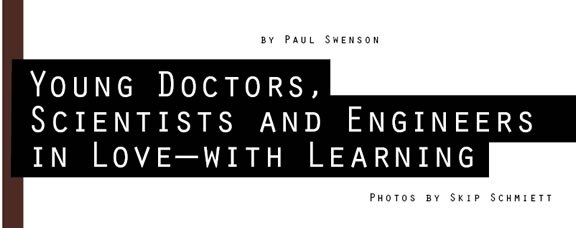
 At
an academy that blends high school and college, students are passionate
about education.
At
an academy that blends high school and college, students are passionate
about education.
by Paul Swenson, photos by Skip Schmiett
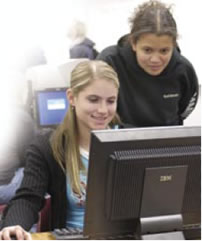 Traditionalist
critics, who tout the cure for what ails American education as a return
to so-called “basics,” might well mistrust the hydra-headed
creature lurking in the corridors and classrooms of the southernmost wing
of Cottonwood High School.
Traditionalist
critics, who tout the cure for what ails American education as a return
to so-called “basics,” might well mistrust the hydra-headed
creature lurking in the corridors and classrooms of the southernmost wing
of Cottonwood High School.
Here at the Academy for Math, Engineering and Science (AMES), one finds no mad scientists, but there are intensely motivated students—including future young biologists, geologists, chemists, mathematicians, engineers and doctors. And they appear to be madly in love with learning.
Renting space from Cottonwood High, AMES opened two years ago to partner with the University of Utah and Granite and Salt Lake school districts under the governor’s initiative to entice more students to pursue science as a career path.
“We’re like a multi-headed animal,” says Al Church MEd’74 EdD’00, principal at AMES. As an educator and administrator, he’s found time over the years to poke his own head into such arcane pursuits as restaurant criticism. In recent years, he’s developed a taste and talent for educational innovation. When I come upon Church in his busy office, stacked with orderly files, he tells me, “Let’s take a walk.” The halls are brimming with young people of several ethnicities and races. “The real fun of this school is the faces of these kids,” he says.
As both a charter school and a higher-ed partnership, AMES’ multiple heads reach mainstream students as well as “underserved kids—minority and low-income students and first-generation college kids,” Church notes.
“Nonetheless, we’re a small school,” he adds—a good thing for the students. “We’ll never have more than 400 kids.”
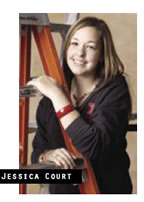 Exposing
high school students to tough college courses and instructors before some
have even set foot on a university campus, and inducing prestigious professors
to leave their campus comfort zones to introduce the rigors of higher
education to high school classrooms is a budding national movement.
Exposing
high school students to tough college courses and instructors before some
have even set foot on a university campus, and inducing prestigious professors
to leave their campus comfort zones to introduce the rigors of higher
education to high school classrooms is a budding national movement.
“The idea is really simple,” Church says. “We’re a blended institution—combining high school and college.”
In 2001, Rich Kendell MEd’70 PhD’73, then executive director of Utah Partnerships for Education (which includes representatives of public and higher education and the business community) and now Commissioner of Higher Education, worked with then-Gov. Michael Leavitt and the Utah Legislature to obtain a grant from the Bill and Melinda Gates Foundation to fund the planning process for six of what were then known as “high-tech high schools.” Each school has become part of a national initiative called Early College High School.
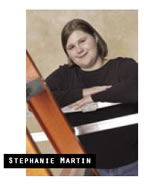 Church
was hired in November 2002 to helm the first of the six schools. AMES’
partnership with a major research university—the University of Utah—is
rare. In such arrangements nationwide, most alliances have been forged
with small community colleges or state schools. Utah’s five other
programs are partnered with Salt Lake Community College, Utah Valley State
College, Southern Utah University, Weber State University and Utah State
University.
Church
was hired in November 2002 to helm the first of the six schools. AMES’
partnership with a major research university—the University of Utah—is
rare. In such arrangements nationwide, most alliances have been forged
with small community colleges or state schools. Utah’s five other
programs are partnered with Salt Lake Community College, Utah Valley State
College, Southern Utah University, Weber State University and Utah State
University.
“We were the first of these schools to model early college high school,” Church says. “Uniquely, our school handpicked our teachers. I work for a board of trustees appointed by the governor, and there is no teacher association. We’re all on a professional, at-will arrangement with the trustees. Teachers commit to the initiative, which takes kids—a diverse population from all over (including 21-plus feeder schools)—and gets them ready for college classes by the end of the 10th grade.”
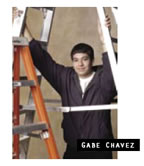 If
you talk to several AMES students from diverse backgrounds and ask what
aspect of the program has had the most impact, many mention the thrill
of meeting the challenge of university course work taught by U of U faculty
(who don’t, incidentally, cut high school students slack just because
they’re young and inexperienced). Greg Owens, assistant professor
of chemistry at the U, is a name that pops up often in conversation.
If
you talk to several AMES students from diverse backgrounds and ask what
aspect of the program has had the most impact, many mention the thrill
of meeting the challenge of university course work taught by U of U faculty
(who don’t, incidentally, cut high school students slack just because
they’re young and inexperienced). Greg Owens, assistant professor
of chemistry at the U, is a name that pops up often in conversation.
“Today, I had Owens for chemistry, and he keeps it really interesting,” says Megy Rexhepaj, 16, a bright, blonde Albanian immigrant, who transferred to AMES from Highland High School. “Often he lectures, but we might have a 20-minute discussion, for example, about how we understand evolution, with everybody making comments or asking questions.”
Emily Dishong, 16, who came to AMES from Churchill Junior High, says Owens’ chemistry class makes her feel as if she already has a foot in college. “I’ve taken other college-level courses, and they’re tougher and harder than high school classes, but in Professor Owens’ class it’s up to us to make the grade independently.”
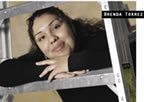 Talk
to Owens himself and he credits his AMES students with nothing less than
revitalizing his teaching career.
Talk
to Owens himself and he credits his AMES students with nothing less than
revitalizing his teaching career.
“Most public schools don’t emphasize learning and understanding of science like this one does,” Owens says. “Too many schools are like factories. In fact, when I look at the mentality of some of my college students, it’s a fitting analogy.” The end product is students who don’t know how to think. “It’s an absolute crime,” Owens adds.
When students with misplaced motivations show up at the U, it can be depressing. “Summer semester, a lot of students seemed to care only about jumping through hoops to get a grade and get out,” he says. “I was feeling very disenchanted.” And then Owens had the chance to teach at AMES. “
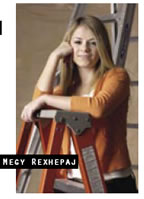 It
couldn’t have come at a better time for me. I’ve had the opportunity
to teach people how to understand and appreciate just how beautiful science
really is. The good news is it builds confidence in my teaching style,
because AMES students are very excited and curious. The change has been
like night and day. “
It
couldn’t have come at a better time for me. I’ve had the opportunity
to teach people how to understand and appreciate just how beautiful science
really is. The good news is it builds confidence in my teaching style,
because AMES students are very excited and curious. The change has been
like night and day. “
In a classroom with 30 students, there’s no place to hide. I can’t get away with anything. It dramatically affects (in a good way) how I teach.”
Our short tour of the facility has showcased the diversity of accents, skin colors and ethnic backgrounds among the students. Explains Church: “Most Advanced Placement (AP) classes don’t have an adequate minority representation, or in some cases, even enough females in math and science. So we’re pretty happy with our demographic. This is because we recruited across the valley to MESA (Math, Engineering, Science Achievement) clubs, specifically targeting minority kids.”
He notes that there is a fairly good cross section—50 percent boys, 50 percent girls; about 30 percent ethnic minorities and 30 percent first-generation college kids. About 30 percent are on fee waivers, and the program is always looking for scholarships.
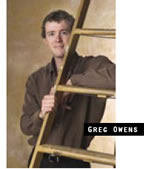 “We’ve
had some nice support from the Utah chapter of the American Council of
Engineering Companies,” says Church, “which has helped support
our students on fee waivers as well as send four students and a teacher
to a national science conference last fall. Two students, Stephanie Martin
and Jo Bradley, are guests today and this evening at a Women in Technology
activity. We’re very focused on our students as individuals.”
“We’ve
had some nice support from the Utah chapter of the American Council of
Engineering Companies,” says Church, “which has helped support
our students on fee waivers as well as send four students and a teacher
to a national science conference last fall. Two students, Stephanie Martin
and Jo Bradley, are guests today and this evening at a Women in Technology
activity. We’re very focused on our students as individuals.”
Marjorie Tuckett, who heads up community-connected learning at AMES, thinks the students often undervalue their potential. “They underestimate the value they have, culturally or socioeconomically, or because of the background of their parents. They could use more good role models in areas where they live, so they can say, ‘I can do this too.’ ” And those who “can do” will end up being role models for others.
As proud as they are of their students’ achievements, Church and Tuckett freely own up to the fact that some kids don’t make it in the program. “We had about 10 percent of our kids leave last year. Some moved, some transferred because it’s a transient population and some kids leave because it’s too hard,” Church says. “But some kids who are struggling with their grades come every day. We believe that we will make them successful.”
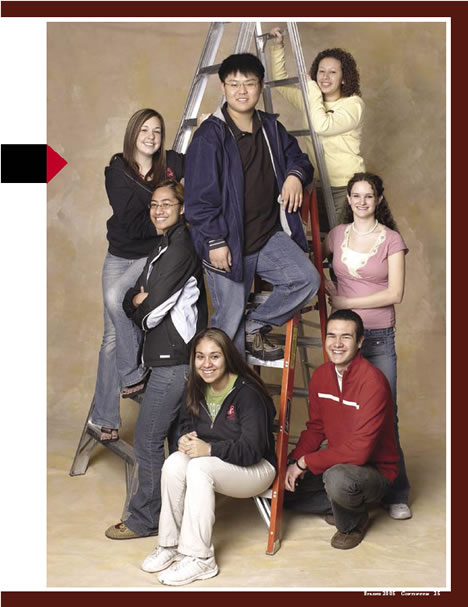
Brenda Torrez, a ninth-grader, and Gabe Chavez, an 11th-grader, are both fresh to the program.
“Last year I went to Brockbank Junior High School and AMES sent me a letter,” Brenda says. “I didn’t immediately accept. I didn’t want to leave my friends. And then this year my cousin told me all about the program, and I got more interested and came and talked to Al Church. I saw it was a good school, and I told him I wanted to come.”
Both students confess that it is “harder here” than likely any other high school experience they could have chosen. “But we learn more here,” Brenda says.
Gabe was lured to apply through the encouragement of his dad, who suggested he would appreciate the smaller classes. He stays because he envisions the opportunities AMES has opened up for him.
Jessica Court’s father also changed her life by pitching the benefits of AMES. “One night my dad walked into my room and asked if I’d be willing to give up Alta High School and my friends for a different school geared toward science,” Jessica recalls. She had already registered at Alta and had her school picture taken, but…“My whole life I wanted to be a doctor,” she says. “It really stuck in my head after my older sister had a baby when I was in fifth grade, and she told me it was uncomfortable to have a male doctor. Not that I necessarily want to be an OB-GYN.”
In the end, Jessica shocked her parents by deciding to attend AMES. “I decided to give it a shot for at least a year,” she says. “I really like it, and I’m sticking with it.”
Jessica is among a host of AMES students with medical ambitions. “We’re sending more kids to the Young Doctors program…,” Church says, momentarily confusing the name of the program with the title of an old screwball comedy film called Young Doctors in Love. “I mean the Future Doctors program at the U—we’re sending more kids there than any other high school in the valley.
”The alliance between AMES and the U has been mutually beneficial. When Church, Kendell, Chuck Wight,(director of the U’s Division of Continuing Education), and representatives of the Gates Foundation huddled in November with the U’s new president, Michael Young, to bring him up to speed on the partnership, the basic question of “Why are we doing this?” came up. Wight had a ready reply from the University’s end: “Because the kids you have in AMES are our students of tomorrow.
”Says Church: “It may not make ‘back to the basics’ critics feel better, but our mission statement is based on our own ‘Three Rs’: ‘Rigor, Relevance and Relationships.’ ”
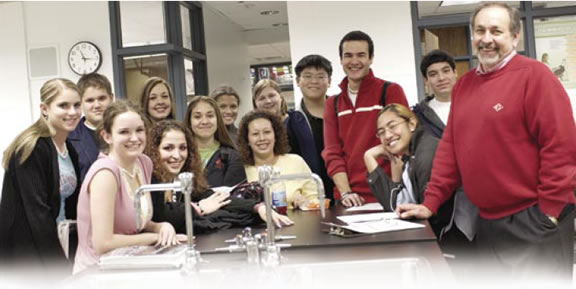
—Paul Swenson is an adjunct faculty member in the Department of Communication at Utah Valley State College (UVSC).